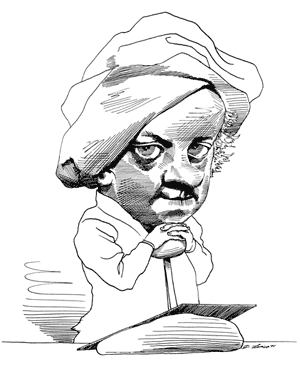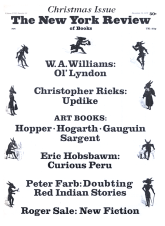This book is vast—a great river of words, flowing majestically on, but like most great rivers, it loops and winds and backtracks. Half a million words on Hogarth! Every parish register, every rate book, all the London newspapers have been ransacked for facts about Hogarth’s parents, even his uncles and cousins. Methodically Ronald Paulson takes us through Hogarth’s father’s life—a record of steady failure: he was in turn schoolmaster, textbook writer, coffee house keeper, and succeeded at none of these. For most of Hogarth’s childhood they lived close to Smithfield Market, as violent, as coarse, and as vital a part of the city of London as one could find; the home of that yearly fiesta of bucolic culture that Bruegel would have reveled in, St. Bartholomew’s Fair with its deformities, conjurers, tricksters, and vulgarities of every hue—an epitome of raw human life at once tawdry and pathetic. Paulson carefully re-creates this tough, cruel world in which Hogarth grew up and, in some ways, the description gains force from this careful, factual, and topographical treatment.
Slowly and steadily we move on through the years of Hogarth’s apprenticeship, when his father was cast into the Fleet Prison, to his days as a silver engraver and his acquaintance with Sir John Thornhill, marriage to his daughter, and emergence as a painter and engraver. Print by print, picture by picture, we follow him to the grave; the careful, critical evaluations are, of course, relieved by the stories of his violent quarrels and his rumbumptious relations with fellow artists. An unquiet character who loved decision and action, the more violent the better, Hogarth bludgeoned his way through the middle decades of the eighteenth century, an obvious genius but seemingly at odds with the mainstream of art of his day.
Most of his historical pictures were a dreadful flop; his conversation pieces often awkward although always fascinating, for it was a genre in which he was never happy. He painted marvelous portraits—surely Captain Coram is one of the finest of the eighteenth century—and yet he was never deeply satisfied as a portraitist. Twice he nearly gave up oil painting altogether, partly because there was so little money in it for him, compared with his engraving, and partly, I suspect, because he knew well enough that his genius was never totally involved, as it was in what most of us would call his satirical prints and what Hogarth once called his modern history paintings. Hogarth, with the self-knowledge of a truly creative artist, was on sure ground—here, if anywhere, lay his originality and his singular excellence. On these great series, A Harlot’s Progress and Rake’s Progress, Marriage à la Mode, Four Stages of Cruelty, and the rest, Professor Paulson is at his best, careful as always, a little long-winded, but truly perceptive; and his analysis is often brilliant.
This painstaking biography is far larger than it need be: at times Professor Paulson quotes a letter in extenso and then gives a precis as long as the letter itself. Given half a chance he will wander off into speculation over what Hogarth might have thought. A good editor could have reduced this book by a third, and it would still have remained the standard factual account of Hogarth, the quarry to which everyone will have to go for a lump of granite or even of gold to use in their own works. It only rarely rises to brilliance yet rarely descends to the commonplace. It is a splendid piece of careful academic scholarship—fabulously well illustrated and wonderfully printed and produced. And yet, to my mind, Paulson never gets Hogarth’s role in eighteenth-century culture sharply in focus. He often makes very valuable comments that help us to understand that role, but he never sees clearly enough that Hogarth was a key element in a cultural revolution that involved not only all the arts of eighteenth-century England but also its leisure, its children, and its games.
What began to develop in England after 1670, at first slowly but with ever-increasing momentum after 1690, was a middle-class market as eager to consume literature, music, and the graphic arts as clothing or pottery. But it was an uncertain market, without fixed standards, a market whose extent was largely unknown. Equally unknown were the methods by which it might be exploited or developed. The people who composed it, as might be expected, were ambivalent both about their own origins, often humble, and about their aspirations, usually genteel.
This was particularly true of their literary and artistic tastes. The bucolic culture of the semiliterate was brilliantly catered for in the crude entertainments of St. Bartholomew’s Fair, which still attracted the growing middle classes but also created in them a sense of uneasiness. They came to prefer the more genteel versions of pantomime. These Londoners of moderate means also hungered for fashion, to be à la mode, and to enjoy the more elegant pleasures of the aristocracy—fine pictures and orchestral music which they lacked the means to provide for themselves, unlike the Duke of Chandos with his orchestra or Sir Robert Walpole with his gallery of old masters. What they could not enjoy personally they came to enjoy vicariously.
Advertisement
In literature, this market was stimulated but never really seized until the publication of The Spectator, which provided exactly the right moral tone—and it is not surprising that it was The Spectator, as Paulson rightly points out, that triggered A Harlot’s Progress and gave Hogarth a success comparable to that of Addison and Steele and for exactly the same reason. And, again as Professor Paulson shrewdly notes, Hogarth’s engravings spoke to audiences at different levels, from the sophisticated to the naïve: for the former there was a complicated moral message, made intriguing by obvious clues that those with inside knowledge could read, and for the latter a simple truth, obvious to all, that the wages of sin are death.
Hogarth provided the pictures that men and women of modest but growing prosperity (or hope of it) wanted on their walls. There had been prints before Hogarth’s, but they had been expensive subscription engravings like those of Thornhill’s paintings at Greenwich or St. Paul’s, either these or prints from Paris or Amsterdam. There were a few political satires, little better than crude woodcuts.
Hogarth however had a very keen market sense and he was as ready as Josiah Wedgwood to exploit any trick that might enlarge his market or protect what he had captured. He used advertisement extensively, organized the Engravers’ Copyright Act, tried auctioning his own pictures, suggested to Jonathan Tyers that his Vauxhall Gardens should have a permanent exhibition of modern paintings, and, of course, he exploited his own studio by allowing pictures to be inspected and, when competition for them was sufficiently strong, selling them to the highest bidder. From the moment he started, Hogarth had a firm eye on sales.
What Hogarth enjoyed most was painting and engraving the stories that would have the widest appeal. He never missed an opportunity to depict contemporary people and events that he thought might sell: whether it was an imposter giving birth to rabbits or a servant girl condemned for slitting two old widow’s throats, Hogarth was there with his pencil. He responded to this new market with speed and dexterity, and sensed brilliantly its ambivalence: its hunger for sensationalism, for titillation of its passions, yet its responsiveness to a stern morality.
Because this audience, market, call it what you will, was Hogarth’s central preoccupation, he was often dissatisfied with his other types of painting conversation pieces, portraiture, and conventional history paintings. Nevertheless, his genius was so ebullient, his eye so quick and perceptive, his brush so fluent that he could not deny his abounding creative virtuosity. So we have the great masterpieces of portraiture and the brilliant oil sketches such as The Shrimp Girl.
Hogarth found a new market for art and exploited it. After A Harlot’s Progress England became a print exporting country and printmaking a considerable industry. As buyers became more confident and more sophisticated, they ventured into fields other than social morality and satire, buying the social elegances of Gainsborough and Reynolds, yet never quite so avidly as they had devoured A Harlot’s Progress.
Paulson suggests that many themes in Hogarth’s modern history paintings sprang from his ambivalence toward riches, which I think is a mistake. Hogarth deplored in his pictures dissipation, ostentation, and wasting money, or stressed the folly of pretending to aristocratic tastes when one was a mere bourgeois—sins that sober apprentices and solid merchants do not commit. Money is too sacred to use profanely.
Hogarth was a part of a wide cultural development in the middle decades of the eighteenth century, the growth of that middle-class consumer market in culture, one which enabled men and women of modest means to buy and borrow books, to purchase prints, and to go to concert halls; to go on holidays to towns designed for leisure; to sit in grandstands to watch sports horse racing and prize fighting—organized for their vicarious pleasure. Those who dominated this market and encouraged it to grow wanted, like Hogarth, to tease as many guineas from its pockets as they could. To do that required intuitive insight into its fears, its aspirations, its longings, as well as its hates and brutalities, and in this intuition Hogarth was as richly endowed as Addison or Steele or Richardson.
This Issue
December 16, 1971




